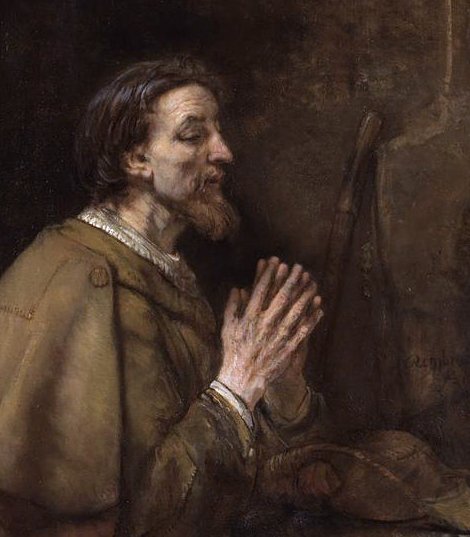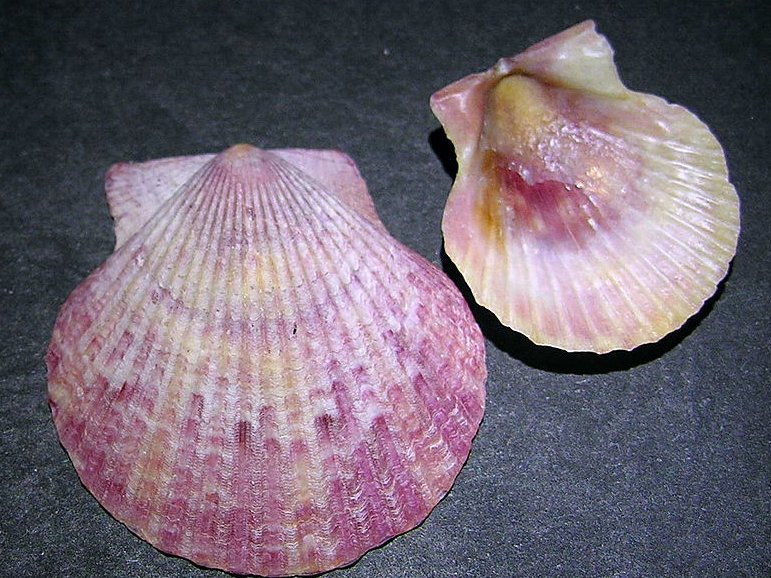The saint named James was connected with bivalve sea shells. In this picture by Rembrandt, though hard to see, St James is said to be wearing such a shell on his shoulder."He is depicted clothed as a pilgrim; note the scallop shell on his shoulder and his staff and pilgrim's hat beside him." (Wikipedia)
"The son of Zebedee and Salome, James is styled 'the Greater' to distinguish him from the Apostle James 'the Less', who was probably shorter of stature. We know nothing of St. James's early life. He was the brother of John, the beloved disciple, and probably the elder of the two ... James' emblem was the scallop shell (or 'cockle shell'), and pilgrims to his shrine often wore that symbol on their hats or clothes. The French for a scallop is coquille St. Jacques, which means 'cockle (or mollusk) of St. James'. The German word for a scallop is Jakobsmuschel, which means 'mussel (or clam) of St. James'; the Dutch word is Jacobsschelp, meaning 'shell of St. James' ... The scallop shell is represented in the decoration of churches named after St. James, such as in St James' Church, Sydney, where it appears in a number of places, including in the mosaics on the floor of the chancel. When referring to St James, the scallop shell is represented with convex perspective. Referring to Venus the perspective is concave ..." (Wikipedia)
Venus, the goddess of the Sea, has the concave half (È) and St James the convex upper half (Ç), which probably represents the sky above. This pair of shells protect the life inside, in the middle (ki roto).
From St Georg's day to the day of St James there are 206 - 113 = 93 days and 365 - 93 = 272. The latter number could be significant because 272 = 2 * 136.
There are 8 days from July 27 to August 4 (= RA day 136) and maybe these allude to or represent the 8 dark nights when Venus is changing her position from evening to morning. But Metoro's words here are not very helpful, it seems. I decided to update my word list by assembling a pair of sentences from other places in the list. And the word ma-haro could be of use for us:
The return of Venus as morning star is something to admire and be astonished by. The first month name listed by Vanaga could mean 'the back side of haro', and possibly Metoro thought of Tua haro when he said e tara tua at the heliacal rising of Mira in April 24. But we should also consider Tara-hao 2 months later: "The ancient names of the month were: Tua haro, Tehetu'upú, Tarahao, Vaitu nui, Vaitu poru, He Maro, He Anakena, Hora iti, Hora nui, Tagaroa uri, Ko Ruti, Ko Koró."
Promising is then the fact that there are 150 days from August 3 (and the heliacal rising of Acubens, α Cancri) to the end of the Gregorian year. Crabs live in the sea and they have shells. With 33 days from the March equinox to the day of St George, there will be a further 150 days ahead to RA day 183 (September 20) = 366 / 2. Possibly there was a calendar model where 5 months with 30 days were alotted to each of the 'bivalve shells'. 33 + 150 + 33 + 150 = 366. However, we are wading in murky waters and the visibility is poor. ... Lobster said to Flounder: 'Let us-two hide from each other, see who is best at that.' Flounder agreed to play this game. Lobster went to a hole in the coral, hid his body; but his feelers stuck out, he could not hide them. Flounder knew where he was, found him. Said Flounder; 'Now it is my turn.' He stirred up a cloud of mud and scooted into it. Then he returned to Lobster's side, so quietly that Lobster did not know he was there. 'Here I am sir, Lobster!' Lobster was so angry at being beaten that he stamped on the fish and smashed him flat. Cried Flounder; 'Now I've got one eye in the mud!' Therefore Lobster gouged it out for him and roughly stuck it back on top. This is the reason why men tread on the Flounder, but can always see the Lobster's feelers outside his hole. | |||||||||||||||||||||||||||||||||||||||||||||||||||||||||||||||||||||||||





